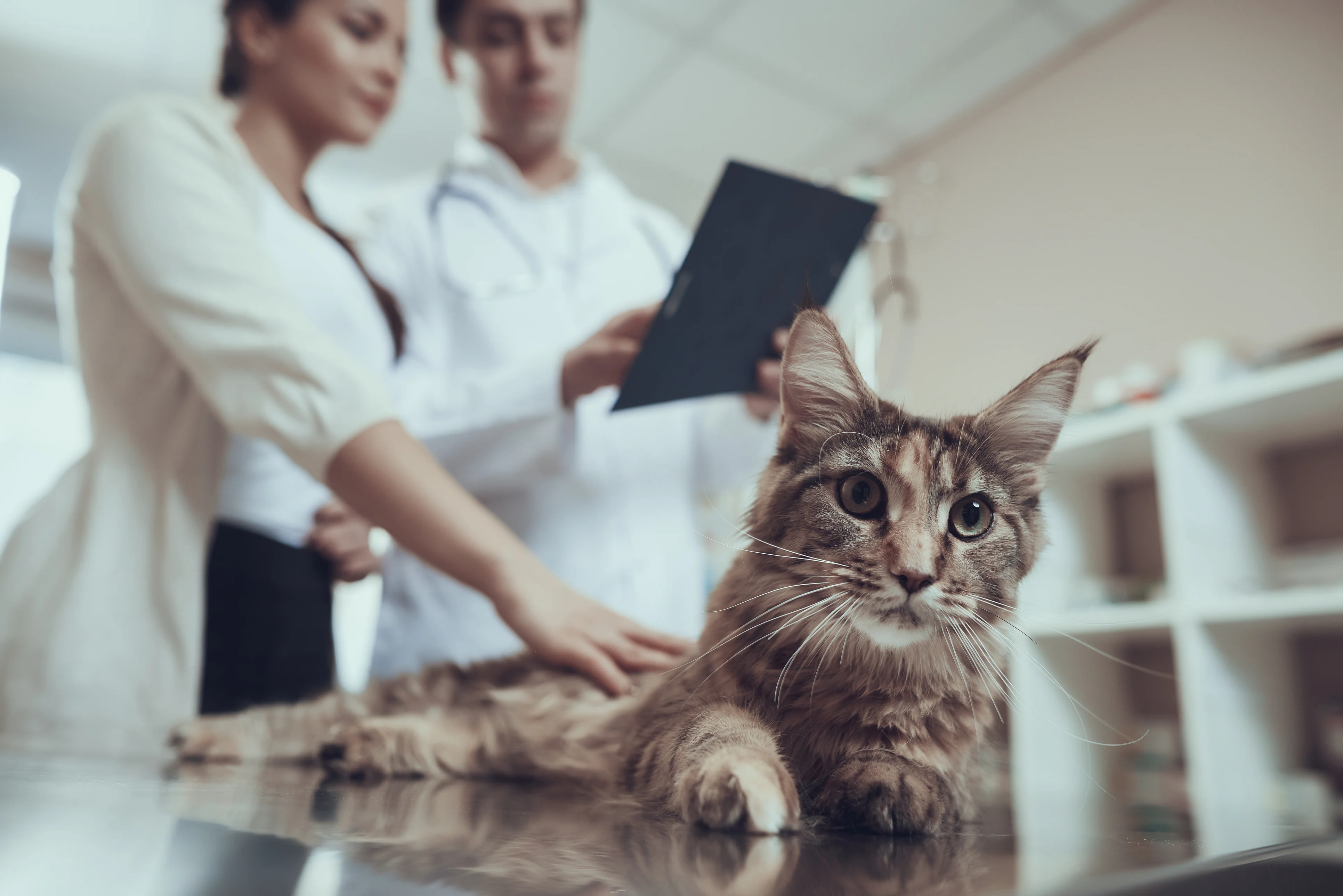Clinical Suite: A Team-Based Approach to Using SGLT2 Inhibitors in Feline Diabetes

Sponsored by Elanco
What Is Feline Diabetes Mellitus?
Diabetes mellitus (DM) is a chronic endocrinopathy characterized by persistent elevation in blood glucose levels. Prognosis is good for well-managed patients, but management can prove challenging for clients and veterinarians.1 Feline DM typically resembles type 2 diabetes in humans, resulting from β-cell dysfunction and insulin resistance. Type 1 DM (immune-mediated DM) is rare in cats. Known risk factors for feline DM include obesity (most common), other endocrinopathies, increasing age, corticosteroid use, and pancreatitis.1
Why Is Feline Diabetes Mellitus Important?
DM is a relatively common condition in cats. Estimates of prevalence vary, ranging from ≈1 in 200 to 1 in 500 cats.2,3 However, studies indicate that the prevalence of feline DM has trended upward in recent decades.4 This means that general practitioners are increasingly likely to encounter this condition in their feline patients.
Feline DM can have significant impacts on affected cats and their owners. Untreated DM poses numerous risks, including diabetic ketoacidosis (DKA), diabetic neuropathy, loss of body condition, and death. With appropriate management, however, the prognosis associated with DM can be good. Unlike in dogs, some cats with DM may enter remission, which may be temporary or permanent.1 A 2023 study estimated the rate of remission in treated cats to be 29%.5
Despite a potentially favorable prognosis, as many as 1 in 10 owners elect to euthanize their cat at the time of diagnosis, likely due to concerns about the demands associated with treatment.6 Even in the case of a committed client, achieving regulation of DM can present significant challenges for both the client and the veterinary team.
Diagnosis of Feline Diabetes Mellitus
The American Association of Feline Practitioners outlines 3 unique requirements that must be met to arrive at a diagnosis of DM:
Documented hyperglycemia (>250 mg/dL)
Documented concurrent glucosuria
One or more of the following supportive findings: history of polyuria/polydipsia with ketonuria, increased serum fructosamine, increased glycated hemoglobin (HgA1c), hyperglycemia at home (≥24 hours after a veterinary visit), and/or glucosuria at home (≥24 hours after a veterinary visit)7
It is important to note that a single elevated blood glucose reading cannot be used to diagnose DM, because stress in cats may cause elevated blood glucose.1 Instead, hyperglycemia must be accompanied by glucosuria and ≥1 additional finding that supports a diagnosis of DM.
Updates in the Treatment of Feline Diabetes Mellitus
In recent years, a new class of drugs, sodium-glucose cotransporter-2 (SGLT2) inhibitors, was approved for the treatment of feline diabetes. These drugs act on SGLT2, a transport protein in the kidney that increases the reabsorption of glucose in the proximal convoluted tubule.8 By blocking SGLT2-mediated glucose reabsorption, SGLT2 inhibitors promote glucose excretion in the urine and decrease patient blood glucose levels.
SGLT2 inhibitors can be a good choice for caregivers who are unable to follow strict administration and monitoring regimens or the specific storage requirements necessary with traditional diabetes treatment options.
Bexacat (bexagliflozin tablets) is a once-daily flavored, chewable SGLT2 inhibitor. This tablet is labeled for the treatment of feline DM in cats weighing ≥6.6 lb (3 kg).9 In a field study, 84% of treated cats were deemed a treatment success by day 56 of treatment.10
Patient selection plays a key role in the successful use of Bexacat. This treatment is appropriate for newly diagnosed diabetic cats that are otherwise healthy, with a good appetite and without significant comorbidities.11 Recommended pretreatment screening to rule out contraindications includes CBC, serum chemistry profile, urinalysis, total thyroxine, and blood beta-hydroxybutyric acid (BHBA) testing.9,11 BHBA is more sensitive than urine testing for ruling out the presence of ketones and can be checked in-clinic using a handheld meter with just one drop of blood.12 Contraindications to treatment include poorly controlled concurrent endocrine disease, pancreatitis, later stages of chronic kidney disease, hepatic disease, and ketosis.9,11 Bexacat is contraindicated in cats that have previously received or are currently receiving insulin, as these cats appear to be at higher risk for DKA associated with Bexacat treatment.11
Bexacat offers simplified administration. Cats receive one 15-mg tablet of Bexacat once daily, regardless of blood glucose level.9 Bexacat can be given with food or on an empty stomach.9
Although all cats undergoing diabetes treatment require at-home monitoring for concerning clinical signs, other aspects of the monitoring protocol vary depending on the therapy used. Patient monitoring requirements for SGLT2 inhibitors differ from protocols for cats receiving insulin. Patients receiving Bexacat should return to the veterinary practice for a recheck examination and BHBA testing 3 to 5 days after starting treatment.8 DKA is the most serious side effect associated with SGLT2 inhibitors, and this complication is most likely to occur within the first 2 weeks of treatment.8,11 Cats receiving SGLT2 inhibitors are uniquely at risk for developing euglycemic DKA, making it imperative to check ketone levels to rule out DKA even in the face of normal blood glucose levels.11 If no reduction in a patient’s BHBA is noted or BHBA persistently rises, Bexacat should be discontinued and the patient transitioned to insulin.9,11 Additional rechecks at 2, 4, and 8 weeks should include a physical examination, BHBA testing, and evaluation of glycemic control via glucose curve, serum fructosamine, or spot glucose checks.9
Long-term monitoring should be performed every 3 to 4 months or as medically appropriate.8 At these visits, evaluations should include patient weight, physical examination, assessment of glycemic control, and BHBA testing.8 Because of the limited risk for clinical hypoglycemia, interstitial blood glucose monitoring and blood glucose curves are not required for cats receiving Bexacat.11
Bexacat should be discontinued if the patient is not responding well to treatment, which may be indicated by signs such as hyporexia, lethargy, weight loss, increasing BHBA, and/or poor or worsening glycemic control.9 The most common side effects associated with SGLT2 inhibitors are gastrointestinal in nature.8,10 In field studies, the most common side effects associated with Bexacat were vomiting, diarrhea, and elevations in BUN, urine specific gravity, and feline pancreas-specific lipase.9
Want to test your knowledge on feline diabetes? Take this quiz!
Managing Feline Diabetes Mellitus: A Team-Based Approach
Every member of the veterinary team has an important role to play in the management of diabetes mellitus, especially in cats receiving Bexacat. To optimize patient care, the entire veterinary team should be involved in DM screening and in caring for affected patients.
Client Service Representative
Schedule diagnostic evaluations promptly and appropriately if pet owners mention observing any clinical signs associated with DM, avoiding a “wait-and-see” approach.
Discuss potential financial solutions that may aid clients in diagnosing and treating their cat’s DM.
Express empathy and understanding for clients whose pets have been diagnosed with DM.
Schedule follow-up visits for cats starting Bexacat therapy at 3 to 5 days, 2 weeks, 4 weeks, and 8 weeks after beginning treatment.
Schedule long-term monitoring visits every 3 to 4 months for patients receiving Bexacat.
Encourage clients to reach out to the veterinary team with any concerns about their cat’s DM or changes in their cat’s clinical signs, including where to seek care outside of normal business hours.
Veterinary Technician/Assistant
Recognize potential signs of DM in the patient medical history and on initial triage examination.
Educate clients about the importance of diagnostic testing for DM.
Present treatment plans related to the diagnosis and/or treatment of DM, discussing potential financial solutions that may aid clients in caring for their pet.
Explain the long-term implications of a DM diagnosis to clients, emphasizing that many cats will require lifelong management.
Express empathy for clients who are concerned about the diagnosis.
Provide tips and tricks to clients who are concerned about administering a daily pill to their cat.
Instruct clients on potential side effects associated with Bexacat and how they should respond if side effects are observed.
Send clients home with relevant educational handouts and other information to support the care of patients with DM.
Work with client service representatives to schedule recommended follow-up visits for 3 to 5 days, 2 weeks, 4 weeks, and 8 weeks after initiating Bexacat therapy.
Work with client service representatives to schedule recheck visits every 3 to 4 months for patients receiving ongoing Bexacat therapy.
Contact clients via telephone or email, as directed by the veterinarian, to monitor at-home response to therapy.
Veterinarian
Identify potential indicators of DM in the patient’s medical history, physical examination, and laboratory tests.
Recommend diagnostic testing for DM when appropriate.
Educate clients about the pathophysiology and prognosis of DM, setting realistic client expectations.
Present treatment options for the management of feline DM, discussing potential challenges of traditional therapies as compared with Bexacat.
Perform recommended pretreatment screening before beginning Bexacat to ensure the patient does not have contraindications to treatment.
Discuss Bexacat dosing and administration.
Provide clients with resources to understand their cat’s disease and actively participate in their care.
Recommend recheck visits 3 to 5 days, 2 weeks, 4 weeks, and 8 weeks after beginning Bexacat therapy.
Perform recommended diagnostic testing at patient rechecks.
Recommend recheck visits every 3 to 4 months for cats receiving Bexacat long-term.
Understand how to identify and screen for euglycemic DKA, a unique risk associated with the use of SGLT2 inhibitors.
Educate clients about potential side effects and emphasize the need for the client to contact the practice with any concerns.
Ensure the team is communicating regularly with clients, especially in the early days of treatment, to monitor patient status.
Conclusion
Diabetes mellitus is a relatively common condition in cats, with significant medical impacts. Although many cases can be managed successfully, traditional treatment options can present challenges for many cat owners. Fortunately, innovative options are now available to make treatment more convenient and improve client compliance for many clients and patients with DM.
Bexacat is a once-daily oral medication approved for the treatment of feline DM. This SGLT2 inhibitor promotes the excretion of glucose in the urine, effectively lowering the blood glucose of cats with DM. Bexacat is contraindicated in cats with poorly controlled concurrent endocrine disease, pancreatitis, later stages of chronic kidney disease, hepatic disease, and ketoacidosis. For cats that are good candidates for an SGLT2 inhibitor, Bexacat is a safe and effective alternative to traditional therapies that can simplify treatment for cats and their human caregivers.
Indication
Bexacat is indicated to improve glycemic control in otherwise healthy cats with diabetes mellitus not previously treated with insulin.
Important Safety Information
Before using this product, it is important to read the entire product insert, including the boxed warning. See package insert for full prescribing information.
Cats treated with Bexacat may be at an increased risk of diabetic ketoacidosis or euglycemic diabetic ketoacidosis, both of which may result in death. Development of these conditions should be treated promptly, including insulin administration and discontinuation of Bexacat. Do not use Bexacat in cats with diabetes mellitus who have previously been treated with insulin, who are receiving insulin, or in cats with insulin-dependent diabetes mellitus. The use of Bexacat in cats with insulin-dependent diabetes mellitus, or the withdrawal of insulin and initiation of Bexacat, is associated with an increased risk of diabetic ketoacidosis or euglycemic diabetic ketoacidosis and death. Sudden onset of hyporexia/anorexia, lethargy, dehydration, diarrhea that is unresponsive to conventional therapy, or weight loss in cats receiving Bexacat should prompt immediate discontinuation of Bexacat and assessment for diabetic ketoacidosis, regardless of blood glucose level. Bexacat should not be initiated in cats with pancreatitis, anorexia, dehydration, or lethargy at the time of diagnosis of diabetes mellitus, as it may indicate the presence of other concurrent disease and increase the risk of diabetic ketoacidosis. Due to risk of severe adverse reactions, do not use Bexacat in cats with evidence of hepatic disease or reduced renal function. Consult a physician in case of accidental ingestion by humans.
Bexacat is a trademark of Elanco or its affiliates. PM-US-25-0767
